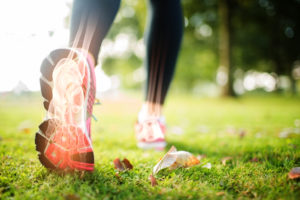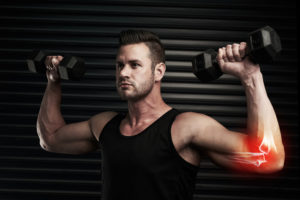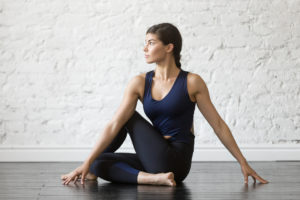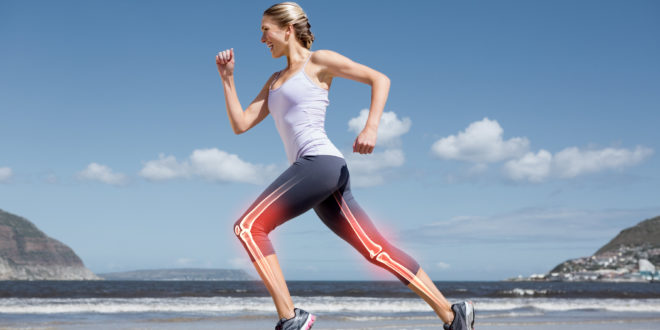As the weather starts to warm, stiff joints begin to thaw. Conditions are prefect for strengthening these critical connectors …
Healthy joints allow us to perform physical activity. We rely on them for every shift, turn, twist— and to sit and stand. Some joints stabilize; others are responsible for movement itself. Strong, healthy joints also can help prevent bone diseases like osteoporosis and arthritis. Here’s how to protect them.
5 for Fluidity
1. Maintain a Healthy Weight
Excess body fat weighs heavily on joints. Each pound on your frame puts four pounds of stress on your knees. Your hips, back, and feet also strain under the burden of extra weight. In addition, excess weight often causes inflammation, which can exacerbate joint pain, stiffness, and swelling.
Lighten Up: Determine your healthy body weight. Schedule your routine evaluation with the Center nurse to determine a healthy BMI and other weight goals. A personal trainer can customize an exercise plan to help maintain, or achieve, your goal weight. Monitor progress through your free follow-up evaluations.
2. Make Sure the Shoe Fits

The best workouts and fitness equipment are only as good as the shoes on your feet. Inappropriate or poorly fitted shoes leave joints susceptible to misalignment, sprains, and pain during and after activity. Usually, frequency of use determines how often to replace worn-out shoes. Don’t judge based on looks. The shoe’s interior support system may diminish before the exterior shows wear.
Step Out: Get properly fitted in the most effective shoes for your sport or workout. Even fully-grown feet shift with age. In addition to sizing, a professional can make shoe recommendations that consider gait, pronation, supination, and activity level. S/he also can advise on replacement frequency.
3. Stretch
Frequent stretching throughout the day improves joint mobility by loosening the surrounding muscles and tendons. This cohesive flexibility between muscles and joints allows for stable, fluid movements. Stretching is an especially important element of every workout. Incorporate stretches after your warm-up and again upon completion.
Reach Farther: Every few hours, perform a series of stretches to tackle the full body. Focus on areas where you personally hold stress, which require the most attention. (See https://fitnessandwellnessnews.com/hidden-stress/) Need ideas? Ask a personal trainer. Until regular stretching becomes a habit, set a reminder on your phone.
4. Strength Train

Joint health is (literally) connected to bone health. One of the best ways to ensure strong, healthy bones is through weight-bearing exercise. Build up your muscles and bones to stabilize your joints. Your joints will have the support needed for their best performance.
Resist: Use the Center’s extensive fitness equipment, free weights, and your own body weight to prevent bone loss while simultaneously building stronger bones. Alternate muscle groups by day to avoid overworking any one area. Ask a trainer to monitor you for proper form to ensure maximum results and minimum risk of injury, including unnecessary strain on joints. Also, ask for tips on how to properly lift/move things to best engage large muscle groups, which reduces joint stress.
5. Stand Tall
Poor posture quickly tires muscles and joints. Ironically, when tired, we tend to slump and slouch, which adds to fatigue. Office syndrome— remaining stationary for extended periods, especially at a desk or computer— can cause poor posture by nature. Then, holding this fixed position for too long exacerbates the issue, leading to stiffness and aches.

Perfect Posture: Mindfulness can eliminate poor posture. Be aware of how you carry yourself. In addition to rolling shoulders forward, poor posture includes squeezing shoulders up toward your ears. Focus on keeping them down and back. Also, note your breathing. Short, shallow breaths can signal poor, tense posture. Breathe fully and from your stomach. Ask a trainer to show you easy posture-improving exercises. Consider a yoga or Pilates class, which emphasizes body-frame work and breath.
The Ultimate Connection
No bones about it. You need to make strong connections with your joints. Nurture them.
Sources
National Institutes of Health at bones.nih.gov.
“16 Ways You May Be Hurting Your Joints,” at webmd.com.
 Fitness & Wellness News Your Source for Fitness News, Wellness News, Health News, and Nutrition News!
Fitness & Wellness News Your Source for Fitness News, Wellness News, Health News, and Nutrition News!




